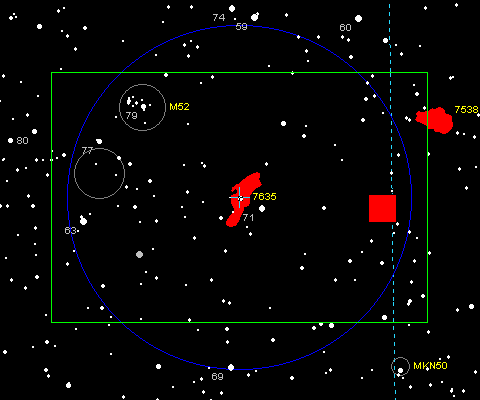|
Introduction
Here is really a debated object: this is the lightest,
simplest and most cheap CCD autoguider on the market, but in some cases
it is not very efficient and many people consider it just an useless
toy.
In my experience,on the contrary, I have found that it can work with
good results: you just have to find a workaround to its main faults.
|
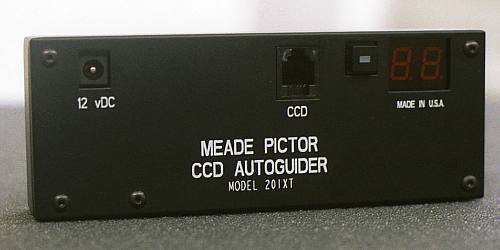 |
|
Contens:
- check your off-axis guider
- focusing the telescope
- search for the best guide star
- set the correct Exposure Time for
the CCD
- focusing the autoguider
- calibration
- Pictor 201XT Mode Diagram
Note: this is not a complete course about the 201XT,
I just describe my solutions for the most important problems: I assume
that you already know the 201XT Users Guide for the general setup.
Other tips about this autoguider are available in the MAPUG
Topical Archive.
|
|
1. check your off-axis guider (OAG)
I do not want to cause a controversial, but in my opinion
with a Schmidt-Cassegrain telescope it is not possible to use a guidescope
for long exposures: the mirror slop will cancel the guiding accuracy.
I wasted a lot of time this way.
Now I use an Off-Axis Guider: it is more difficult to find a good star,
but the OAG uses the same objective that makes the photo and compensates
for possible slops.
Check your OAG and measure the difference between the optical axis and
the centre of the OAG eyepiece's field of view. For example in the Meade
OAG I have found a difference of about 45 arc minutes.
A direct look in the camera and in the eyepiece is probably the easiest
way to get this measure. It will be useful for chosing a correct guide
star.
|
|
2. focusing the telescope for the
photography
I describe my methods
in another page.
Anyway you must not change this position when you will focus the CCD.
|
|
3. search for the best guide star
The Pictor 201XT works better with guide
stars between mag.4 and mag.8. It is not cooled: for this reason you
cannot use very faint stars and for better results you always have to
look for the brightest star that is possible.
I study the situation on a sky atlas: I use Megastar
3, but suppose that other programs are good as much.
Look at the chart below: it is an example for a photo of NGC
7635
|
|
The green rectangle is
the field of the 35mm camera; the blue circle is the center of the
OAG eyepiece field of view rotated around the optical axis (in this
example for the Meade OAG: as I said its radius is 45').
You have to find a good star on this circle, if possible by letting
the nebula in the center of the field. Actually it should be on
the inferior semicircle: since the telescope gives inverse images
this way the guiding port will stay up (it is very difficult to
look in an eyepiece directed below!). Note that for the same reason
the real position of the guiding port will always be opposite to
the position of the star in the chart.
|
This chart shows an ideal
situation with a good guide star (mag.6.9) in the perfect position
to let the Bubble Nebula in
the center of the image. Other cases are less lucky, but almost
everytime I can find a satisfactory configuration...really some
objects are very difficult (or quite impossible!).
Usually I work on the configuration in the days before and print
a chart to be used near the telescope: with a "mirror"
chart you will have the exact field as seen in the OAG eyepiece.
Be sure to avoid double stars (apparent double too...) with a bright
companion within a 1 arc minute radius and remember that star catalogues
contain a lot of errors: when you will have found a good star check
it with another catalogue! |
|
|
Now you are ready to start: center the object in the
camera field and look for the guide star you chose rotating the OAG
and moving (not much!) the telescope until it is centered, first in
a wide field eyepiece then in a hight power reticle.
Now you have to chose the correct Et.
|
|
4. set the correct Exposure time
for the CCD
The Pictor 201XT has a range of Exposure times (Et) from 0.1 to 25 seconds.
Of course a shorter time gives a better result, cause it means more
frequent corrections; only in rare cases a quite long Et could minimize
the harmful influence of a very bad seeing (in these cases is probably
better to stay at home and look at TV...).
The relationship between
Et and the star mag. (for brightness values of about 20) is described
in the diagram on the right. It is obtained by a LX200 8" f:6.3
and the Meade OAG.
It is rule-of-thumb at all, founded on my experience and probably
not very correct, but it can give you an idea of the initial Et
for starting setup. Usually I find that this is also the right time
for guiding the photo. |
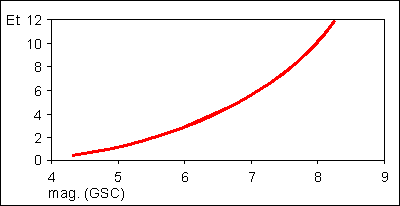 |
|
|
5. focusing the autoguider
| |
You have
already focused the photocamera. Now do not use the focus knob of
the telescope: for focusing the Pictor move it up and down in the
OAG eyepiece holder.
I have studied the criticality of the focus accuracy and show it
in this diagram: I moved the focus by 2/10mm steps reading the corresponding
brightness value (actually it is the average of five readings).
The diagram says which precision is required and you can make an
accurate job only adding a graduated scale to the Pictor's barrel
as shown in the picture. In my opinion 0.75mm steps are a good compromise
between precision and concrete realization.
|
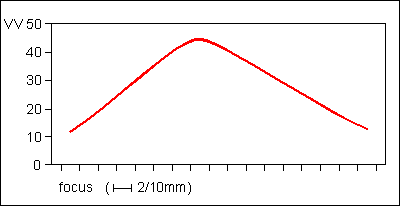 |
|
I simply used a strip of paper (drawn
and printed by the pc) rolled up to the barrel; you can see the
section below: the height is 12 mm and the width 99 mm.

Move the Pictor of one step (control
the position with the edge of the eyepiece holder) and read the
brightness values until you get the maximum.
Increase then Et if you do not have at least a value of 15-20
in the perfect focus.
|
 |
|
|
6. calibration
The 201XT works better if the CCD is parallel to RA
and dec. circles: this way you minimize the bad influence of dec. axis
backlash and it is easier to center the guide star with the slow motions
of the telescope.
As
described by M.Hart in the Mapug topical archive you can get this
result rotating the autoguider in the same number of degrees and direction
as you rotated the OAG eyepiece around the optical axis.
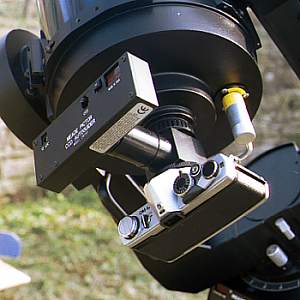 |
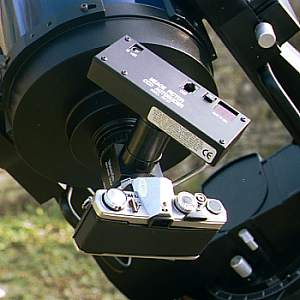 |
Now we have a problem: with the Meade OAG it is not
possible to rotate the Pictor more than 50° because it touchs the
telescope. The solution is turn the autoguider of the inverse of the
complementary angle.
For example: if you have rotated the OAG of 75° clockwise, turn
the 201XT of 90°-75°=15° anticlockwise: the CCD chip will
be parallel to the reversed axis. Reading the position of the guide
star on the display the first digit will show the dec. and the second
digit the RA.
I recalibrate every time, because I cannot be sure to insert
the autoguider exactly in the same position of the last time.
A tip: if your telescope obstinately refuse to calibrate and shows Error
in the display try to turn the Pictor of few degrees.
|
|
7. Pictor 201XT Mode Diagram
I redrew the User guide's mode diagram for using near
the telescope.
|

